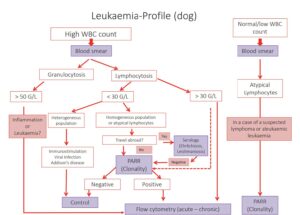Leukaemia is a neoplastic proliferation usually of one leukocyte population in the bone marrow. Often this is noted as a marked leukocytosis in the peripheral blood. However, there are cases of so called aleukaemic leukaemia with panleucopenia as the only sign, since the neoplastic cells are located only in the bone marrow and therefore hinder the haematopoiesis of the remaining cells.
Lymphoid leukaemia is the most frequent form. Less frequent myeloid leukaemia is observed, which is a neoplastic proliferation of monocytes, granulocytes but also erythroid progenitor cells as well as megakaryocytes (progenitor cells of thrombocytes).
In lymphocytic leukaemia an uncontrolled clonal proliferation of one cell-type occurs (T-cell, B-cell or natural killer (NK)-cell types), based on one single stem cell. This clonal proliferation can be proven using the PARR (PCR for Antigen Receptor Rearrangements) test at LABOKLIN. In human medicine, the immunophenotyping by flowcytometry has been a well-established and important tool for leukaemia diagnosis, as prognosis and therapy significantly differ with certain forms. In dogs the immunophenotype is the strongest prognostic factor. This is still studied in cats, currently the prognosis is mainly based on the FeLV/FIV status.
- Fig. 1: leukaemia profile in dogs
Beside the clonality testing for confirmation of the diagnosis, LABOKLIN now also offers a leukaemia differentiation using of flow cytometry in dogs. Alongside a differentiation of lymphoid and myeloid, a differentiation of lymphocytic leukaemia as T-helper cell, cytotoxic T-cell and B-cell type and especially a distinction of acute and chronic leukaemia are now possible.
Unlike lymphomas, the prognosis is less determined by the cell type (B or T) but by classification in acute and chronic. Whereas an acute myeloid or lymphoid leukaemia shows a significantly shortened survival rate (4 to 6 months) in dogs, chronic B- and T-cell leukaemia runs an indolent course, with a survival time of over 1.5 years. Additionally, the absolute cell count has to be considered too, as leukaemia from <30.000 cells/µl have a more favourable prognosis than ><30.000 cells/µl have a more favourable prognosis than >30.000 cells/µl.
Therefore LABOKLIN now offers a leukaemiaprofile which, for dogs, includes a complete blood count, blood film examination, a clonality testing using PARR for confirmation of a neoplastic proliferation and flow cytometry to determine the immunophenotype as well as to distinguish between acute and chronic forms. For cats, the leukaemia-profile also includes a complete blood count, blood film examination, PARR-PCR, and FeLV-FIV status.
This profile not only allows confirmation of the diagnosis but also a better estimation of the prognosis as well as the choice of an appropriate therapy (Fig. 1).


